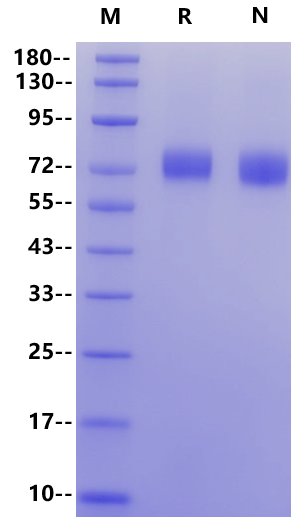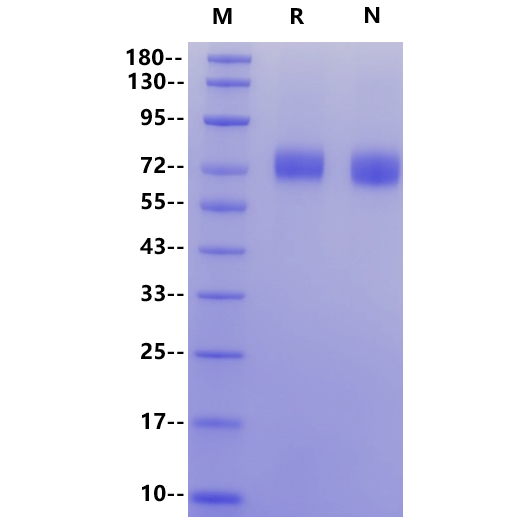Product Details
Product Details
Product Specification
| Species | Mouse |
| Synonyms | FCRL5, FcRH3, BXMAS1, CD307, Fc receptor homolog 5, Fc receptor-like 5, IFGP5, IRTA2, PRO820 |
| Accession | Q68SN8 |
| Amino Acid Sequence | Gln27-Ala496, with C-terminal 10*His QHEAAQQSVVSLQPPWTTFFRGEVVTLTCYRFGFSVPQKTKWYQKRKTVKQTPGALVIKAHTLKVHESGEYWCQADSLLPSMHVNVEFSEDFLVLQAPPAVFEGDSVVLRCYAKKGIEAETLTFYKDGKALTLHPQSSEFYIHRANLKDNGQYKCTSKKKWSFGSLYTSNTVVVQVQELFPRPVLRARPSHPIDGSPVTLTCQTQLSAQKSDARLQFCFFRNLQLLGSGCSRSSEFHIPAIWTEESKRYQCKAETVNSQVSKQSTAFIIPVQRASARFQTHIIPASKLVFEGQLLLLNCSVKGVPGPLKFSWYKKDMLNKETKILKSSNAEFKISQVNISDAGEYYCEANNSRRSFVSRAFPITIKVPVSQPVLTLSTGKTQALEGDLMTLHCQSQRGSPCILYEFFYENVSLGNSSILSGGGAYFNFSMSTERSGNYYCTADNGLGAQCSEAIRISIFDMTKNRSVPMAGGGSGGGSHHHHHHHHHH |
| Expression System | HEK293 |
| Molecular Weight | 70-85kDa |
| Purity | >95% by SDS-PAGE |
| Endotoxin | <0.1EU/μg |
| Conjugation | Unconjugated |
| Tag | His Tag |
| Physical Appearance | Lyophilized Powder |
| Storage Buffer | PBS, pH7.4 |
| Reconstitution | Reconstitute at 0.1-1 mg/ml according to the size in ultrapure water after rapid centrifugation. |
| Stability & Storage | · 12 months from date of receipt, lyophilized powder stored at -20 to -80℃. · 3 months, -20 to -80℃ under sterile conditions after reconstitution. · 1 week, 2 to 8℃ under sterile conditions after reconstitution. · Please avoid repeated freeze-thaw cycles. |
| Reference |
1、Davis R S. et al. (2007) Fc receptor-like molecules. Annu. Rev. Immunol. 25: 525-560. 2、Maltais L J. et al. (2006) New nomenclature for Fc receptor-like molecules. Nat. Immunol. 7: 431-432. |
Background
Fc Receptor-Like 5 (FCRL5), also known as FcRH3 (FcRH5 in human), IRTA2, and CD307e, is a 90 ‑ 95 kDa member of the FCRL family of proteins. FCLR molecules are type 1 transmembrane proteins that contain from three to nine immunoglobulin-like domains. They are differentially expressed within the B cell lineage, and can either promote or inhibit B cell proliferation and activation. Mature mouse FCRL5 consists of a 470 aa extracellular domain (ECD), a 21 aa transmembrane segment, and a 79 aa cytoplasmic region. CRL5 expression is restricted to mature B lineage cells in lymphoid tissues and blood, and is particularly noted to be expressed on T‑independent marginal zone and B1 B cells. Its ligation inhibits signaling through the B cell antigen receptor. Epstein-Barr virus transformation of B cells induces the up‑regulation of surface FCRL5 by a direct effect of its EBNA2 protein on FCRL5 gene transcription. Notably, the FCRL5 protein is preferentially expressed in cell lines with 1q21 abnormalities, and is up‑regulated on tumor cells in some types of B cell malignancies.
Picture
Picture
SDS-PAGE

1μg (R: reducing condition, N: non-reducing condition).


